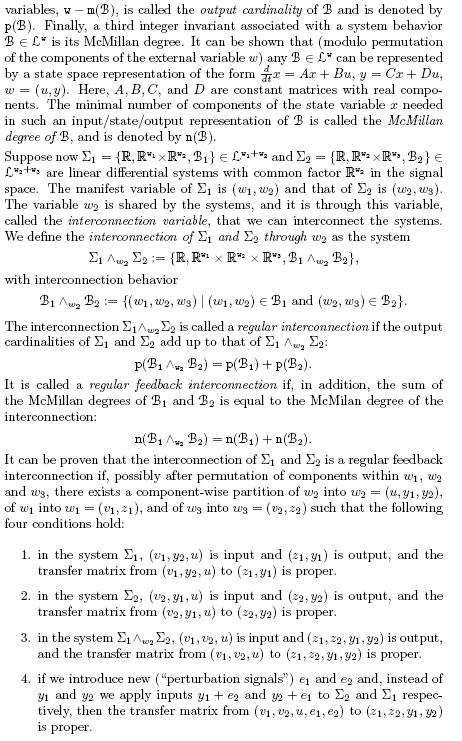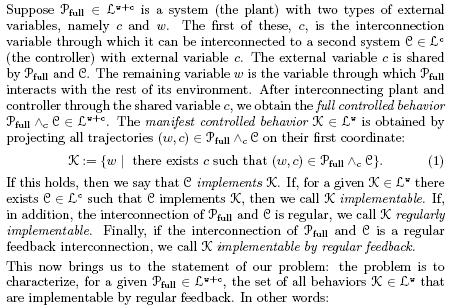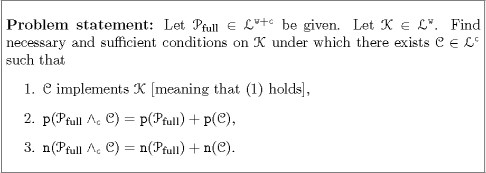Problem 1.10
Regular feedback implementability of linear differential behaviors
H. L. Trentelman
Mathematics Institute
University of Groningen
P.O. Box 800, 9700 AV Groningen
The Netherlands
1 INTRODUCTION
In this short paper, we want to discuss an open problem that appears in the context of interconnection of systems in a behavioral framework. Given a system behavior, playing the role of plant to be controlled, the problem is to characterize all system behaviors that can be achieved by interconnecting the plant behavior with a controller behavior, where the interconnection should be a regular feedback interconnection.
More specifically, we will deal with linear time-invariant differential systems, i.e., dynamical systems ![]() given as a triple
given as a triple ![]() where
where ![]() is the time-axis, and where
is the time-axis, and where ![]() called the behavior of the system
called the behavior of the system ![]() is equal to the set of all solutions
is equal to the set of all solutions ![]() of a set of higher order, linear, constant coefficient, differential equations. More precisely,
of a set of higher order, linear, constant coefficient, differential equations. More precisely,




The first three of these conditions state that, in the interconnection of ![]() an
an![]() along the terminals of the interconnected system one can identify a signal flow that is compatible with the signal flow diagram
of a feedback configuration with proper transfer matrices. The fourth condition states that this feedback interconnection
is “well-posed.” The equivalence of the property of being a regular feedback interconnection with these four conditions was
studied for the “full interconnection case” in [8] and [2].
along the terminals of the interconnected system one can identify a signal flow that is compatible with the signal flow diagram
of a feedback configuration with proper transfer matrices. The fourth condition states that this feedback interconnection
is “well-posed.” The equivalence of the property of being a regular feedback interconnection with these four conditions was
studied for the “full interconnection case” in [8] and [2].
2 STATEMENT OF THE PROBLEM


Effectively, a characterization of all such behaviors ![]() gives a characterization of the “limits of performance” of the given plant under regular feedback control.
gives a characterization of the “limits of performance” of the given plant under regular feedback control.
3 BACKGROUND
Our open problem is to find conditions for a given ![]() to be implementable by regular feedback. An obvious necessary condition for this is that
to be implementable by regular feedback. An obvious necessary condition for this is that ![]() is implementable, i.e., it can be achieved by interconnecting the plant with a controller by (just any) interconnection through
the interconnection variable c. Necessary and sufficient conditions for implementability have been obtained in [7]. These
conditions are formulated in terms of two behaviors derived from the full plant behavior
is implementable, i.e., it can be achieved by interconnecting the plant with a controller by (just any) interconnection through
the interconnection variable c. Necessary and sufficient conditions for implementability have been obtained in [7]. These
conditions are formulated in terms of two behaviors derived from the full plant behavior ![]()

P and N are both in ![]() and are called the manifest plant behavior and hidden behavior associated with the full plant behavior
and are called the manifest plant behavior and hidden behavior associated with the full plant behavior ![]() respectively. In [7] it has been shown that
respectively. In [7] it has been shown that ![]() is implementable if and only if
is implementable if and only if
![]()
i.e., ![]() contains
contains ![]() , and is contained in
, and is contained in ![]() This elegant characterization of the set of implementable behaviors still holds true if, instead of (ordinary) linear differential
system behaviors, we deal with nD linear system behaviors, which are system behaviors that can be represented by partial differential
equations of the form
This elegant characterization of the set of implementable behaviors still holds true if, instead of (ordinary) linear differential
system behaviors, we deal with nD linear system behaviors, which are system behaviors that can be represented by partial differential
equations of the form
![]()
with ![]() a polynomial matrix in n indeterminates. Recently, in [6] a variation of condition (2) was shown to be sufficient for implementability
of system behaviors in a more general (including nonlinear) context.
a polynomial matrix in n indeterminates. Recently, in [6] a variation of condition (2) was shown to be sufficient for implementability
of system behaviors in a more general (including nonlinear) context.
For a system behavior ![]() to be implementable by regular feedback, another necessary condition is of course that
to be implementable by regular feedback, another necessary condition is of course that ![]() is regularly implementable, i.e., it can be achieved by interconnecting the plant with a controller by regular interconnection
through the interconnection variable c. Also for regular implementability necessary and sufficient conditions can already
be found in the literature. In [1] it has been shown that a given
is regularly implementable, i.e., it can be achieved by interconnecting the plant with a controller by regular interconnection
through the interconnection variable c. Also for regular implementability necessary and sufficient conditions can already
be found in the literature. In [1] it has been shown that a given ![]() is regularly implementable if and only if, in addition to condition (2), the following condition holds:
is regularly implementable if and only if, in addition to condition (2), the following condition holds:

case ![]() = 0 (which is equivalent to the “full interconnection case”), conditions (2) and (3) for regular implementability in the
context of nD system behaviors can also be found in [4]. In the same context, results on regular implementability can also
be found in [9].
= 0 (which is equivalent to the “full interconnection case”), conditions (2) and (3) for regular implementability in the
context of nD system behaviors can also be found in [4]. In the same context, results on regular implementability can also
be found in [9].
We finally note that, again for the full interconnection case, the open problem stated in this paper has recently been studied in [3], using a somewhat different notion of linear system behavior, in discrete time. Up to now, however, the general problem has remained unsolved.
BIBLIOGRAPHY
[1] M. N. Belur and H. L. Trentelman, “Stabilization, pole placement and regular implementability, ” IEEE Transactions on Automatic Control, May 2002.
[2] M. Kuijper, “Why do stabilizing controllers stabilize ?” Automatica, vol. 31, pp. 621-625, 1995.
[3] V. Lomadze, On interconnections and control, manuscript, 2001.
[4] P. Rocha and J. Wood, “Trajectory control and interconnection of nD systems, ” SIAM Journal on Contr. and Opt., vol. 40, no 1, pp. 107-134, 2001.
[5] J. W. Polderman and J. C. Willems, Introduction to Mathematical Systems Theory: A Behavioral Approach, Springer Verlag, 1997.
[6] A. J. van der Schaft, Achievable behavior of general systems, manuscript, submitted for publication, 2002.
[7] J. C. Willems and H. L. Trentelman, “Synthesis of dissipative systems using quadratic differential forms, Part 1, ” IEEE Transactions on Automatic Control, vol. 47, no. 1, pp. 53-69, 2002.
[8] J. C. Willems, “On Interconnections, Control and Feedback, ” IEEE Transactions on Automatic Control, vol. 42, pp. 326-337, 1997.
[9] E. Zerz and V. Lomadze, “A constructive solution to interconnection and decomposition problems with multidimensional behaviors, ” SIAM Journal on Contr. and Opt., vol. 40, no 4, pp. 1072-1086, 2001.
